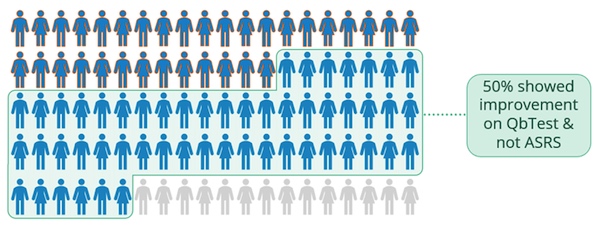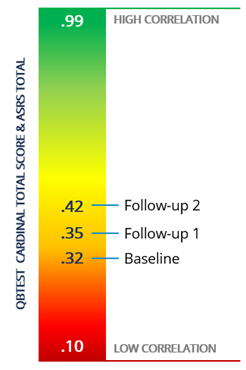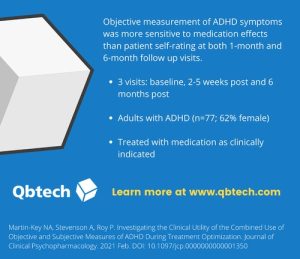New study finds ADHD test serves as a better indicator of medication effects

In a study of 77 adult patients, clinical interviews, self-rating scales, and QbTest were used at baseline and at two follow-up appointments after starting treatment.
At the second follow-up appointment six months after initiating treatment, QbTest captured clinically significant symptom improvement in 86% of patients who initiated treatment (represented by all blue figures below), compared to just 37% of patients’ rating scales reflecting symptom improvement (figures outlined in orange).
This means that approximately 50% of patients’ QbTest results captured treatment response that was not reflected by rating scales (blue figures in the shaded green portion).


The magnitude of the relationship between rating scales and QbTest increased over time, with more alignment at six months than baseline or initial follow-up, as represented by the image to the left.
This may be explained by the under reporting of symptoms, and increased awareness of their own symptoms over the course of their treatment.
This study’s results are in line with a previous study showing that 54% of adult ADHD patients’ self-ratings were less sensitive to treatment effects than QbTest. Results of both of these studies indicate the need for a comprehensive view of ADHD’s impact on patients. This view would best be served to include both an objective and subjective perspective on all three core symptoms of ADHD to enhance the clinician’s ability to make treatment decision.
So why is this important to know?
As a clinician, if your patient reported minimal effect after adhering to their treatment for six months, would you increase the dose? Would you change the type of treatment? If the decision to modify medication was made, this research indicates that the changes in treatment could be unnecessary approximately 50% of the time.
By adding objective ADHD testing like QbTest into your current evaluation methods, you will be provided with robust data on your patients’ symptomatology to help guide decisions around titration and efficacy to achieve optimal patient outcomes. Having those test results to share with your patients helps support your own judgement and provide the patient with additional reasoning for your decision, therefore improving psychoeducation.
Want to find out more about the research?

